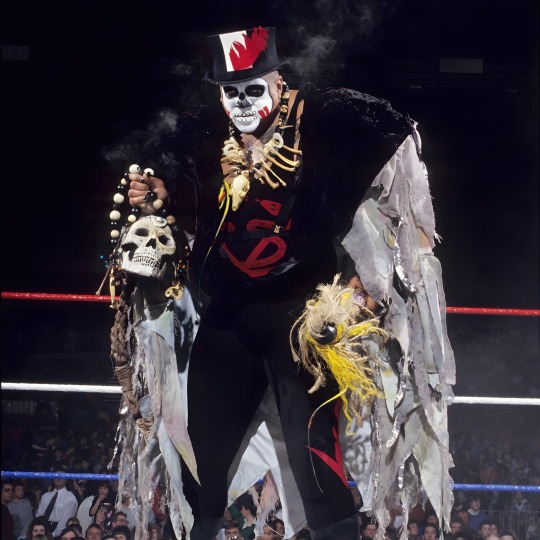#PAPA SHANGO
Explore tagged Tumblr posts
Text
Long story short : my roommates own the house we live in - they’re getting divorced and selling the house - so I’m having to pack everything I own in preparation for when it sells.
I’m going through everything and found my little fanny pack full of wrestling novelties. I had a subscription box for a while, before AEW was a thing, and I’d always get random ass items. Like this one.
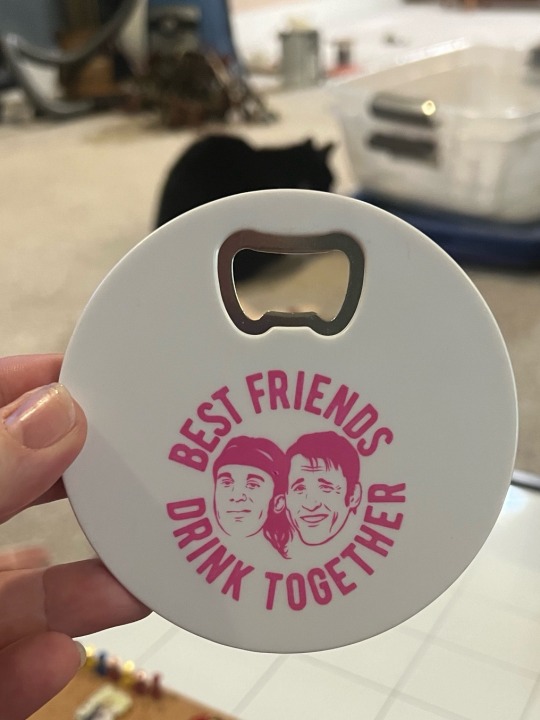
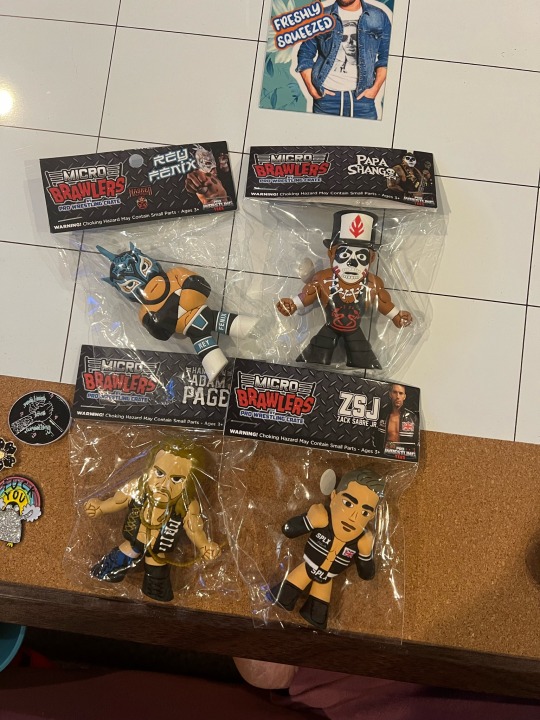
#random wrestling merch#wrestling#best friends#chuck taylor#chuckie t#trent beretta#Trent?#hangman adam page#rey fenix#zsj#zack sabre jr#papa shango
15 notes
·
View notes
Text
To get more in the Halloween spirit...








Some of my favourite 'Creepy'/'horror' themed wrestlers, I swear the Boogeyman used to scare the hell out of me but he's so entertaining to watch 😭
#The undertaker#undertaker#wwe undertaker#kane#wwe kane#papa shango#the boogeyman#finn balor#finn bálor#sting#the crow sting#i love him sm#mankind#Love him as well <33#bray wyatt#the fiend#wwe#wwf#90s wwf#90s wrestling#wwf attitude#world wrestling federation
6 notes
·
View notes
Text

#the boogey man#the godfather#keith lee#naomi#papa shango#big e#bobby lashley#bianca blair crawford#bianca belair#jade cargill
38 notes
·
View notes
Text
Wrestlemania Main Event Reviews - Wrestlemania VIII
Hulk Hogan def. Sid Justice w/ Harvey Wippleman in 12:28
Technically, this show has a double main event but like does it really? No disrespect to Savage/Flair but it was not really given any distinction there. I would have put it on last though! Wippleman introduces Justice, then Fink introduces Hogan! The entrance way is vibrant this year! Beginning of Mania set design! Justice attacks as soon as Hogan gets in the ring, ducks down with a rope rebound but Hogan is ready and sends him to the outside. Real American does not stop playing throughout. Justice slowly gets back in the ring to start. Sid gets going with some vicious kicks and tries to tear Hogan’s face off. Menacing stuff from Sid! The exact same rope rebound spot happens! Sid looks dumb there! Back inside and Sid wants to lock up. Test of strength happens and the crowd wills on Hogan but Sid is too much! Hogan mounts the comeback though! This is very slow but Sid is still too strong once Hogan is on his feet. Knees in the corner. Hogan is able to hit a clothesline in the corner, but Wippleman on the apron allows Sid to hit a big chokeslam! Sid yells at the camera about doing unto the man what he would do unto you but doing it first. He laughs at this. Strikes to Hogan and he’s sent outside. Wippleman distracts Hebner while Sid uses Wippleman’s doctor’s bag as a weapon. Shoulder claw back in the ring for a long time. What is it with these matches and long uses of submission moves that don’t look great. Arm drop spot from a shoulder claw? Does that work? Hulking up but big side suplex from Sid. Big powerbomb but Hogan kicks out and Hulks up. Big boot but Sid stays up so powerslam! Leg drop and Sid kicks out! Wippleman gets in the ring, the bell is rung, Hogan picks him up immediately and throws him at Sid. Here comes Papa Shango who was meant to break up the pin off the leg drop but missed his cue. He stops running at one point because he realises he screwed up. Sid and Hogan brawl and then Shango joins the fight! Ultimate Warrior comes down to even the odds with a massive clothesline to the outside to Shango. Sid attacks with the chair but Hogan grabs it and the heels escape. Hogan is announced as the winner by DQ. What a mess but the crowd are enjoying the two faces in the ring! Hogan lifts up a Warrior sign from the crowd and Warrior does the Hogan poses for a bit.
Pros: Sid hits some big moves that looked good, action was pretty decent Cons: Run of the mill, Sid made to look dumb, REALLY botched finish, the actual DQ made no sense, maybe not the choice of main event.
This match was fine for the most part, but one of the infamously worst finishes ever hampered it further. Really nothing to say other than talk about the end, Shango missing his cue, Sid having to kick out, nonsense DQ (the bell rang on time as if Shango had done his bit!). Just a mess really with little in-ring to save it.
1 STAR OUT OF 5

#wrestlemania main event reviews#wrestlemania 8#wrestlemania#wwe#wrestling#pro wrestling#hulk hogan#sid justice#sycho sid#sid vicious#harvey wippleman#papa shango#ultimate warrior
3 notes
·
View notes
Text
The Fiend was inspired by Papa Shango
2 notes
·
View notes
Photo
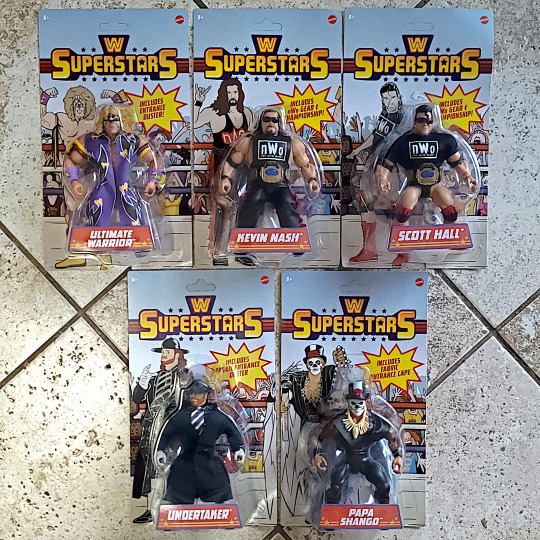

Ultimate Warrior - WWE Superstars [Series 2] - Mattel / WWE
Kevin Nash - WWE Superstars [Series 2] - Mattel / WWE
Scott Hall - WWE Superstars [Series 2] - Mattel / WWE
Undertaker - WWE Superstars [Series 3] - Mattel / WWE
Papa Shango - WWE Superstars [Series 3] - Mattel / WWE
#Ultimate Warrior#undertaker#nwo#WWE#Wrestling#action figures#Kevin Nash#Scott Hall#papa shango#mattel#collectible#acquisitions
3 notes
·
View notes
Text
The If Factor: Papa Shango Returns to WWF in 1997
The If Factor: Papa Shango Returns to WWF in 1997
Brian Damage The ‘If Factor’ are a series of articles that takes a look at real scenarios in pro wrestling that at one point or another were suggested, planned, considered…but did not get the green light to continue. What would the landscape of professional wrestling look like if these ideas came to fruition? Continue reading Untitled
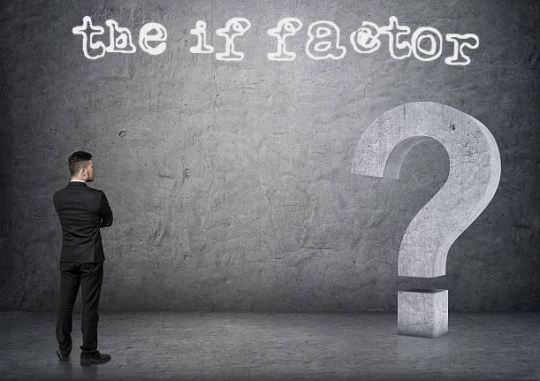
View On WordPress
0 notes
Text
These are also the bad guy thots in my brain saying the villain dialogue.

These are the bad guy thoughts in my brain coming up with villain dialogue
12 notes
·
View notes
Text
#knowledge#love#wisdom#life#spirituality#karmicstar#orisha#yoruba#soul#oya high#sango#chango#shango#papa legba
56 notes
·
View notes
Text
I'm so faceblind I'm watching this video about WWF gimmicks and I'm learning about how many guys leave and then come back and i'm just "WAIT THOSE ARE THE SAME GUY?"
0 notes
Text
Religious discrimination
#daddy was gonna print out figurines for the nurses station.#3d printer#daddy helps us heal from Joseph#papa legba#(that got the initiated one OUTSIDE the glass)#oya#shango#chango???#xango???
0 notes
Text
RE: Was Baron Samedi worshiped in New Orleans prior to the late 20th century?
This one is also about the actual lwa.
Baron Samedi can aptly be described as not just the most iconic lwa, but one of the most iconic things from New Orleans Voodoo. Ironically, I have only found inconclusive evidence that he was worshiped in New Orleans during the 19th or early 20th centuries.
In American popular media, Baron Samedi is frequently conflated with other Haitian deities, called the Gede. The real-life Baron Samedi has his origins in Haitian Vodou, as does Maman Brigitte (Gran Brijit). The Haitian lwa are derived from African deities, among the most important being the Dahomean trickster god Legba (himself, derived from the Yoruba deity Eshu). Over the course of Haitian history, Dahomean Legba was refracted into Papa Legba, Met Kalfou, and the Gede - by extension, the Bawons, including Baron Samedi. This explains why the Gede are trickster deities of sexuality and liminality, who embrace all that is taboo - just like Dahomean Legba!
19th Century New Orleans Voodoo was greatly influenced by Haitian Vodou, due to the massive influx of Haitian refugees that arrived in the Crescent City after the Haitian Revolution. Following the post-Revolution migration wave, several Haitian lwa became features of New Orleans Voodoo, including:
Papa Legba → “Papa Limba” or “La Bas”, syncretized with St. Peter
Damballah → “Daniel Blanc”, syncretized with St. Michael
Agassu → “Yon Sue”, syncretized with St. Anthony
Ogou Feray could have also been worshiped as “Joe Ferraille” (“Joe Feray”), and Ayizan Velekete as “Vériquité”. While the Erzulies were not directly worshiped per se, veneration of Mother Mary was a key feature of 19th century New Orleans Voodoo. (The Erzulies are syncretized with Mother Mary.)
(I should also note that, in New Orleans, the lwa were called “spirits”, while Bon Dieu/Bondye was simply called “God”)
During the 19th century, the two most important lwa were probably Papa Legba - the Doorkeeper - and Damballah - the most ancient of the lwa. This would explain why their names appear most frequently in 19th- and 20th-century sources, especially in large scale rituals. Damballah might have been refracted into multiple deities, including “Daniel Blanc” and “Zombi the Snake God” – a deity famously associated with Marie Laveau. Others argue that “Grand Zombi” is actually derived from the Kongo supreme deity Nzambi Mpungu, or an invention fabricated by journalists.
A third key deity – “Onzancaire” / “Monsieur Assonquer” – might have been associated with Ogou Feray – one of the most important Haitian lwa. However, the origins of “Onzancaire” are elusive. Because so many different theories have been proposed, I do not know where his true origins lie.
Other deities of non-Haitian origin were also features of New Orleans Voodoo. St. Marron (Jean St. Malo) was the New Orleanian folk saint of runaway slaves. Mother Leafy Anderson – founder of the Spiritual Church Movement in New Orleans – introduced worship of the Native American Saint Black Hawk (see: Kodi A. Roberts (2015) Voodoo and Power: The Politics of Religion in New Orleans, 1881–1940). My understanding is that “Dr. John” (Jean Montaigne) was also deified, in a similar manner to St. Black Hawk. Orisha, such as Shango and Oya, may too have been worshiped. Other deities are listed here and here.
Baron Samedi is conspicuously absent. I think this has to do with the history of Haitian Vodou. Prior to the Haitian Revolution, Haitian Vodou was less of an organized religion, described as a "widely-scattered series of local cults" (see: The Social History of Haitian Vodou, p. 134). It was between the years 1804 and 1860 that Haitian Vodou began to stabilize into a clear predecessor of its present form. (see: The Social History of Haitian Vodou, p. 139) This period of stabilization took place after the migration wave of the early 19th century, which could explain why key features of Haitian Vodou are missing from 19th century New Orleans. For example, I have yet to find evidence that division of the Petwo and Rada lwa made it over to American soil. The refraction of Dahomean Legba might have never been transmitted by Haitian refugees, which would explain the absence of Met Kalfou and the Gede/Bawons from worship.
This too explains why the Papa Legba of American history was both Doorkeeper AND Guardian of the Crossroads. It has been theorized that the legendary “Devil at the Crossroads” was actually Met Kalfou. However, this “Devil” does not match the appearance of Kalfou, described as "no ancient, feeble man...huge and straight and vigorous, a man in the prime of his life." Instead, the one at “the Crossroads” appears as a limping old man who loves music and dogs (“Hellhound on my Trail”). It’s Papa Legba!
Rather than Kalfou, I think American Papa Legba actually inherits his more menacing attributes from Eshu. This would explain why he walks with a limp (like Eshu), is notoriously vengeful (like Eshu), and is sometimes described as androgynous (like Eshu!).
In any case, the Papa Legba of American history can be clearly traced back to Haiti. His appearance as a limping old man is inherited from Haitian Papa Legba; his love of dogs and music from Dahomean Legba. 19th century sources clearly identify him with Saint Peter (“St. Peter, St. Peter, open the door;”) The same cannot be said for Baron Samedi. He was probably not syncretized with St. Expedite, because St. Expedite “did not achieve popularity until the late 1800s or early 1900s in New Orleans” – long after the Haitian migration wave.
I have found one compelling source that places worship of Baron Samedi in 19th century New Orleans. Creole author Denise Alvarado is something of an expert on this topic, her being born and raised in New Orleans. In Witch Queens, Voodoo Spirits, and Hoodoo Saints: A Guide to Magical New Orleans (2022), Denise Alvarado identifies a “Spirit of Death” with Baron Samedi / Papa Gede. The most convincing piece of evidence comes from the second interview, in which the interviewee describes a ceremony where attendees donned purple robes. The color purple has been historically associated with Papa Gede (by extension, Baron Samedi).
That being said, I do think the evidence Alvarado provides is tenuous. Without additional context, it’s difficult to say whether the purple robes are truly linked to the Haitian lwa. The other newspaper article sounds rather sensationalized. The 19th century saw horrendous news coverage of New Orleans Voodoo, where reporters would exaggerate or straight-up fabricate details to demonize Vodouisants. The reporter’s description of the spirits of death does not align with the Haitian Gede or Bawons. It is important to remember that New Orleans Voodoo is not entirely Haitian in origin. Several other traditional African spiritualities are woven into New Orleans Voodoo. Prior to the Haitian migration wave of the early 19th century, one of the main influences was Kongo spirituality, in which ancestor veneration is central. Additionally, the newspaper cited is from the year 1890 – years after Marie Laveau’s death. The reliability of this article is therefore questionable. I think this could be a Damballah / “Grand Zombi” situation, where this “Spirit of Death” bears superficial resemblance to the lwa but isn’t actually him. It is also possible that he is simply a fabrication by journalists.
The defamation of Vodou continued into the early 20th century, as Haiti was occupied by the U.S. between the years 1915 and 1934. I don’t see how worship of the Gede/Bawons could have been transmitted to New Orleans between the end of the Haitian migration wave and year 1934. There’s a good chance that Baron Samedi / Papa Gede only properly became features of New Orleans Vodou during the revitalization movement of the late 20th century.
As such, I propose two hypotheses:
Baron Samedi was not properly worshiped in New Orleans until the late 20th century. He quickly rose in popularity, as he was easily grafted onto the pre-existing worship of the spirits of the dead (ancestors).
Alvarado has correctly identified Baron Samedi / Papa Gede with the “Spirit of Death”; however, this “Spirit of Death” was a radical departure from his Haitian predecessor, taking on a markedly different form from the lwa.
But that’s all just a Theory… A GAME THEORY!!!
…Anyways, annotated bib:
Marshall, Emily Zobel. American Trickster: Trauma, Tradition and Brer Rabbit. Rowman & Littlefield, 2019.
Chapter 1 ("African Trickster in the Americas") describes Dahomean Legba’s origins in the Yoruba deity Eshu.
Cosentino, Donald. "Who is that fellow in the many-colored cap? Transformations of Eshu in old and new world mythologies." Journal of American Folklore (1987): 261-275. https://www.jstor.org/stable/540323.
From the abstract: “Myths of Eshu Elegba, the trickster deity of the Yoruba of Nigeria, have been borrowed by the Fon of Dahomey and later transported to Haiti, where they were personified by the Vodoun in the loa Papa Legba. In turn, this loa was refracted into the corollary figures of Carrefour and Ghede.” Accessed here: https://www.centroafrobogota.com/attachments/article/24/17106647-Ellegua-Eshu-New-World-Old-World.pdf
Haitian immigration : Eighteenth and Nineteenth Centuries. The African American Migration Experience. https://www.inmotionaame.org/print.cfm@migration=5.htm
Describes post-Haitian Revolution migration wave like so: “the number of immigrants [from Haiti to New Orleans] skyrocketed between May 1809 and June 1810… The 1809 migration brought 2,731 whites, 3,102 free persons of African descent, and 3,226 enslaved refugees to the city, doubling its population.”
Fandrich, Ina J. “Yorùbá Influences on Haitian Vodou and New Orleans Voodoo.” Journal of Black Studies, vol. 37, no. 5, 2007, pp. 775–91. JSTOR, http://www.jstor.org/stable/40034365. Accessed 23 June 2024.
Mentions worship of Ogou Feray as “Joe Ferraille”. Fandirch herself cites Long, C. M. (2001). Spiritual merchants. Knoxville: University of Tennessee Press, p. 56: https://archive.org/details/spiritualmerchan0000long/page/56/mode/2up?
Long, Carolyn Morrow. A New Orleans voudou priestess: The legend and reality of Marie Laveau. University Press of Florida, 2007, p. 247: https://books.google.com/books?id=_XzSEAAAQBAJ&pg=PT247#v=onepage&q&f=false
Mentions worship of Ayizan Velekete as (the male) “Vériquité”.
Anderson, Jeffrey E. Hoodoo, voodoo, and conjure: A handbook. Bloomsbury Publishing USA, 2008, p. 15: https://books.google.com/books?id=TH7DEAAAQBAJ&pg=PA15&lpg=PA15#v=onepage&q&f=false
Relevant quote: "Blanc Dani, Papa Lébat, and Assonquer make the most frequent appearances in both nineteenth- and twentieth-century sources. The first two, in particular, figure prominently in large-scale rituals."
Humpálová, Denisa. "Voodoo in Louisiana." (2012). https://dspace5.zcu.cz/bitstream/11025/5338/1/BP%20Denisa%20Humpalova%202012.pdf
One of several sources that identifies “Grand Zombi” with Nzambi Mpungu.
Long, Carolyn Morrow. A New Orleans voudou priestess: The legend and reality of Marie Laveau. University Press of Florida, 2007, p. 247: https://books.google.com/books?id=_XzSEAAAQBAJ&pg=PT247#v=onepage&q&f=false
Posits that “Grand Zombi” could be derived from Nzambi Mpungu, or "may be the invention of journalists inspired by "zombie tales" of Haiti's infamous living dead, combined with Moreau de Saint-Méry’s endlessly repeated description of a snake-worshiping ceremony in colonial Saint Domingue."
Anderson, Jeffrey E. Voodoo: An African American Religion. LSU Press, 2024, p. 46: https://www.google.com/books/edition/Voodoo/O-v3EAAAQBAJ?hl=en&gbpv=1&dq=%22assonquer%22+%22azewe%22+vodou&pg=PA46&printsec=frontcover
Describes several possible origins for the elusive “Onzancaire”, including a theory that he was a deity related to Ogou Feray.
Long, Carolyn Morrow. A New Orleans voudou priestess: The legend and reality of Marie Laveau. University Press of Florida, 2007, p. 236: https://books.google.com/books?id=_XzSEAAAQBAJ&pg=PT236#v=onepage&q&f=false
One of several sources to describe St. Marron (Jean St. Malo).
Roberts, Kodi A. Voodoo and Power: The Politics of Religion in New Orleans, 1881-1940. LSU Press, 2015, p. 82: https://books.google.com/books?id=EWOkCgAAQBAJ&pg=PT82&lpg=PT82
Describes how Mother Leafy Anderson (founder of the Spiritual Church Movement) “found” St. Black Hawk, introducing him to New Orleans Voodoo.
Alvarado, Denise. Witch Queens, Voodoo Spirits, and Hoodoo Saints: A Guide to Magical New Orleans. Weiser Books, 2022, p. 39: https://books.google.com/books?id=ktlWEAAAQBAJ&pg=PA39&lpg=PA39#v=onepage&q&f=false
Posits that high priestess Betsy Toledano worshiped the Orisha Shango and Oya during the 19th century.
Anderson, Jeffrey E. Hoodoo, voodoo, and conjure: A handbook. Bloomsbury Publishing USA, 2008, p. 15: https://books.google.com/books?id=TH7DEAAAQBAJ&pg=PA15&lpg=PA15#v=onepage&q&f=false
List of deities worshiped in 19th century New Orleans Voodoo.
Alvarado, Denise. Witch Queens, Voodoo Spirits, and Hoodoo Saints: A Guide to Magical New Orleans. Weiser Books, 2022, p. 126: https://www.google.com/books/edition/Witch_Queens_Voodoo_Spirits_and_Hoodoo_S/ktlWEAAAQBAJ?hl=en&gbpv=1&pg=PA126
Another list of deities worshiped in 19th century New Orleans Voodoo.
Mintz, Sidney & Trouillot, Michel-Rolph (1995) “The social history of Haitian Vodou” in Cosentino, Donald J., ed., Sacred Arts of Vodou, Chapter 4. LA: UCLA Fowler Museum, 123-47. P. 134: https://ghettobiennale.org/files/Trouillot_Mintz_LOW.pdf
Describes Haitian Vodou as a "widely-scattered series of local cults" prior to the Haitian Revolution.
Mintz, Sidney & Trouillot, Michel-Rolph (1995) “The social history of Haitian Vodou” in Cosentino, Donald J., ed., Sacred Arts of Vodou, Chapter 4. LA: UCLA Fowler Museum, 123-47. P. 139: https://ghettobiennale.org/files/Trouillot_Mintz_LOW.pdf
Describes the stabilization of Haitian Vodou into a predecessor of its current form. This occurred between the years following the Haitian Revolution and year 1860.
Deren, Maya. Divine Horsemen : The Living Gods of Haiti. New Paltz, NY: McPherson, 1983 (originally published in 1953), p. 101: https://archive.org/details/divinehorsemenli00dere/page/100/mode/2up
Description of Kalfou (Carrefour) as "no ancient, feeble man...huge and straight and vigorous, a man in the prime of his life." Deren conducted her ethnographic work during the 1940s and 1950s.
Marvin, Thomas F. “Children of Legba: Musicians at the Crossroads in Ralph Ellison’s Invisible Man.” American Literature, vol. 68, no. 3, 1996, pp. 587–608. JSTOR, https://doi.org/10.2307/2928245. Accessed 23 June 2024.
Description of “The Devil at the Crossroads” as a musical genius and “limping old black man”: “Most versions of this story instruct the aspiring musician to bring his instrument to a lonely crossroads at midnight and await the arrival of a limping old black man who will tune the instrument, play it briefly, and then return it endowed with supernatural power."
Robert Johnson’s song “Hellhound on My Trail” identifies “The Devil at the Crossroads” with Papa Legba, who is associated with dogs.
Long, Carolyn Morrow. A New Orleans voudou priestess: The legend and reality of Marie Laveau. University Press of Florida, 2007, p. 244: https://books.google.com/books?id=_XzSEAAAQBAJ&pg=PT244&lpg=PT244#v=onepage&q&f=false
Relevant quote: "Mary Washington, born in 1863, said she was trained in the arts of Voudou by Marie Laveau. She remembered a song that was sung at the weekly ceremonies: "St. Peter, St. Peter open the door; I am callin' you, come to me; St. Peter, St. Peter open the door." Mrs. Washington explained that "St. Peter was called La Bas, St. Michael was Daniel Blanc, and Yon Sue was St. Anthony." She also mentioned a spirit called Onzancaire."
Alvarado, Denise. The Magic of Marie Laveau: Embracing the Spiritual Legacy of the Voodoo Queen of New Orleans. Weiser Books, 2020, p. 57: https://books.google.com/books?id=SZOMDwAAQBAJ&pg=PA57&lpg=PA57#v=onepage&q&f=false
Relevant quote: “Baron Samedi remains a popular and powerful force in New Orleans Voudou today, along with his wife Manman Brigit. He is syncretized with St. Expedite, among the most popular of saints in New Orleans. We do not hear of St. Expedite in association with Marie Laveau, however, because he did not achieve popularity until the late 1800s or early 1900s in New Orleans (Alvarado 2014).”
Alvarado, Denise. Witch Queens, Voodoo Spirits, and Hoodoo Saints: A Guide to Magical New Orleans. Weiser Books, 2022, pp. 127-128: https://books.google.com/books?id=GsofEAAAQBAJ&pg=PA127&lpg=PA127#v=onepage&q&f=false
This is the strongest evidence I could find that Baron Samedi / Papa Gede was worshiped in 19th - early 20th Century New Orleans.
Deren, Maya. Divine Horsemen : The Living Gods of Haiti. New Paltz, NY: McPherson, 1983 (originally published in 1953), p. 107: https://archive.org/details/dli.ernet.505921/page/107/mode/2up?q=purple
Historical evidence that, since at least the 1940s, Papa Gede’s colors are “black or purple”. To this day, purple is associated with Baron Samedi and the Gede as a whole.
Long, Carolyn Morrow. A New Orleans voudou priestess: The legend and reality of Marie Laveau. University Press of Florida, 2007, p. 250: https://books.google.com/books?id=_XzSEAAAQBAJ&pg=PT250&lpg=PT250
Relevant quote: “The religion that evolved in nineteenth-century New Orleans and was embraced by Marie Laveau and her Voudou society combined traditions introduced by the first Senegambian, Fon, Yoruba, and Kongo slaves with Haitian Vodou, European magic, and folk Catholicism. It also absorbed the beliefs of blacks imported from Maryland, Virginia, and the Carolinas during the slave trade of the 1830s–1850s. These “American Negroes” were English-speaking, at least nominally Protestant, and practiced a heavily Kongo-influenced kind of hoodoo, conjure, or rootwork. New Orleans Voudou is therefore not identical to Haitian Vodou, but represents a unique North American blend of African and European religious and magical Traditions.”
Fandrich, Ina J. “Yorùbá Influences on Haitian Vodou and New Orleans Voodoo.” Journal of Black Studies, vol. 37, no. 5, 2007, pp. 775–91. JSTOR, http://www.jstor.org/stable/40034365. Accessed 23 June 2024.
Describes major Senegambian and Kongo influences on New Orleans Voodoo, prior to the Haitian Revolution. Relevant quote: “New Orleans's African population was Kongo dominated with a strong affinity with the spirits of the dead…Dahomeyan influence occurred only indirectly through the Haitian refugees who "flooded" the city after 1808. In 1809 alone, more than 10,000 Haitians arrived, and doubled the city's population. They brought their Vodou religion with them, which ultimately merged with the already existing New Orleans or Louisiana Voodoo traditions. During the French colonial regime, 80% of the enslaved Africans came from one single ethnic group: the Bamana (also called Bambara) people from the Senegal River basin (today's Senegal, Gambia, and Mali), most of them stemming from one single ethnic group, the Bambara people. The majority of the remaining 20% were Kongolese and some Dahomeyans (Hall, 1992). Despite their rather different geographical origins, these two cultures blend easily into one another. Eighteenth-century Louisiana Voodoo maintained a marked Senegambian flavor, with some Kongolese elements blended in, until the end of the 18th century.”
Dubois, Laurent. “Vodou and History.” Comparative Studies in Society and History, vol. 43, no. 1, 2001, pp. 92–100. JSTOR, http://www.jstor.org/stable/2696623. Accessed 23 June 2024.
An overview of the history of Haitian Vodou, as it pertains to U.S. history. Demonization of Vodou continued past the U.S. occupation of Haiti, until the late 20th century.
#between the two it is 100% papa legba who had a bigger impact on horror stories from the american south of the early 20th century#i think a lot of people would think it's baron samedi but no! it's the mischevious limping old man!#commentary#the loa (hazbin hotel)#baron samedi (hazbin hotel)#big papa legba
9 notes
·
View notes
Text
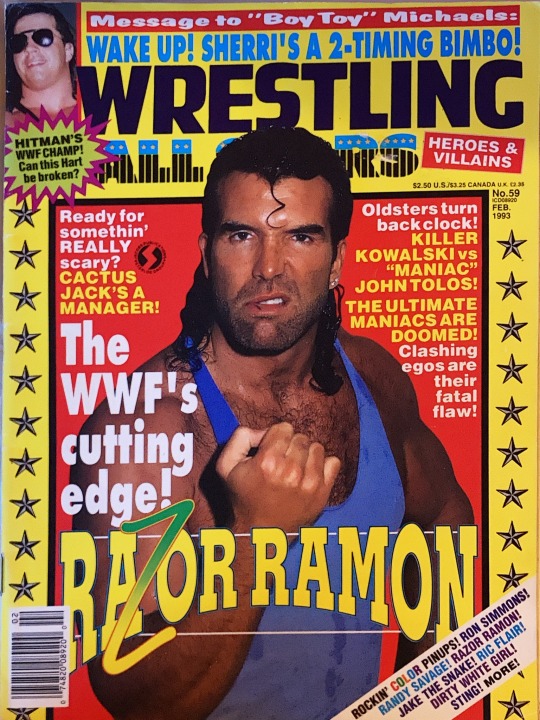
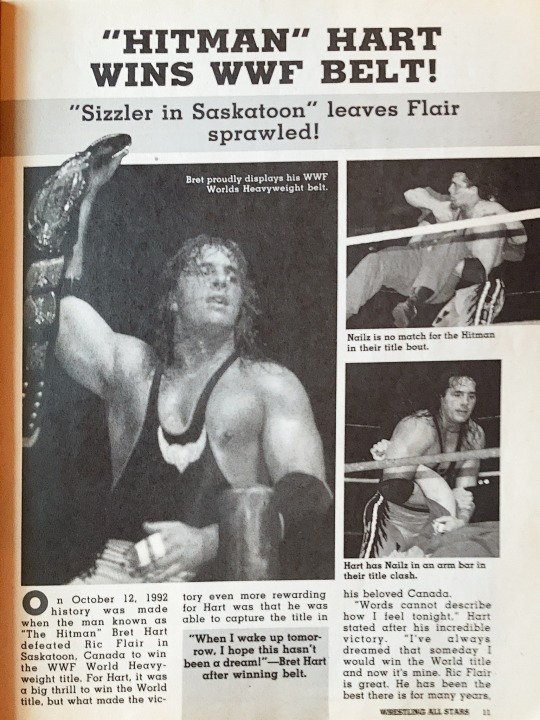


WRESTLING ALL STARS: Heroes and Villains : February 1993
“HITMAN” HART WINS WWF BELT!
“Sizzler in Saskatoon” leaves Flair sprawled!
[Bret proudly displays his WWF Worlds Heavyweight belt.
Nailz is no match for the Hitman in their title bout.
Hart has Nailz in an arm bar in their title clash.]
On October 12, 1992 history was made when the man known as “The Hitman” Bret Hart defeated Ric Flair in Saskatoon, Canada to win the WWF World Heavyweight title. For Hart, it was a big thrill to win the World title, but what made the victory even more rewarding for Hart was that he was able to capture the title in his beloved Canada.
[“When I wake up tomorrow, I hope this hasn’t been a dream!”--Bret Hart after winning belt.]
“Words cannot describe how I feel tonight,” Hart stated after his incredible victory. “I’ve always dreamed that someday I would win the World title and now it’s mine. Ric Flair is great. He has been the best there is for many years, but tonight I guess you can say I was just a little bit better. The thought that I’m really the World champion still hasn’t been a dream.”
Two days before the bout in Canada Bret Hart faced Ric Flair in Los Angeles with the belt on the line.
[Bret shows off his Intercontinental strap.
Piper hits the mat compliments of the Hitman during their Wrestlemania brawl.]
In that bout Hart seemingly pinned Ric Flair and even left the ting with the belt. But the following day when Mr. Perfect and Bobby Heenan protested that the referee who made the call was not the official referee, the WWF commission reversed the decision and the championship belt was returned to Ric Flair. Flair, however, didn’t have his precious “10 pounds of gold” too long. Just two days later, Hart pulled the upset of the year.
After his incredible victory, Bret Hart, speaking to Mean Gene Okerlund on the WWF Superstars of Wrestling TV program made his first appearance as champion and gave a rousing interview.
[Hart is a true credit to his profession. He is more than worthy of the honor that has been bestowed upon him.]
“I can’t tell you how proud I am,” Hart told the TV audience. “This is the greatest moment in my whole life, and I dedicate it to all the people who believe that our biggest dreams can come true. Since I was a kid I’ve been involved in wrestling. My whole family has been involved in wrestling. My father trained me and took me on the mat. I listened and learned and dedicated myself to mastering technical wrestling. I followed up on all the little details, never thinking I knew it all because you just never know it all. I’ve had my share of wins. I’ve had my share of losses, but you just wait your whole life for that one single chance and fortunately I got that chance. I have to thank every wrestler that I ever wrestled against. I’ve wrestled the greatest wrestler in the world and I learned so much. In particular I have to thank Ric Flair for giving me this chance. I want to thank each and every one of my fans around the world who supported me all these years. I want to thank all my friends that backed me up through thick and thin. I want to thank my family who have been with me since I was a little baby, and most of all I want to thank God above. Thank you for the greatest moment in my life. I’m proud to be the WWF World champion.”
[Hart shows off his World Tag Team title strap.
Hart and Jim “the Anvil” Neidhart are former WWF Tag Team champions.]
With Hart’s victory he joins Pedro Morales as the only man to hold the WWF tag team belt, the Intercontinental title and now the World belt. The new champion, however, should have a tough time trying to hold on to his newly won crown. Ric Flair, Razor Ramon, Papa Shango, Nailz, the Berzerker, Shane Michaels and possibly even Mr. Perfect are gunning for the new champ. With challenges like this, Bret Hart will have his work cut out for him, but if anyone can handle himself against the best in the sport it’s Bret Hart.
It’s great to see someone like Hart wearing the WWF Heavyweight championship strap. He’s a true credit to the profession and more than worthy of the honor that has been bestowed upon him.
#Bret hart#bred#bret hitman hart#wwf#world wrestling federation#magazine scan#magazine transcript#WRESTLING ALL STARS: Heroes and Villains#WRESTLING ALL STARS: Heroes and Villains 1990s#1990s#1993
9 notes
·
View notes
Text
Pasivas
Las marcadas con un * son personales.
Poder de Tres: (Próximamente)
*Arco de Cupido: Reliquia mágica en actual posesión de Persephone Halliwell, regalo de su padre, Coop, cuando esta cumplió los dieciséis. Efecto: contra NPCs a los que superes en AGI (Agilidad), tus dos primeros ataques de combate se consideran a distancia y no recibes contra-ataque. Contra PJs, salvas tantas Pifias de Ataque en combate como puntos de AGI le superes, convirtiéndolas en 3.
*Anillo de Cupido: Reliquia mágica en actual posesión de Penelope Halliwell, regalo de su padre, Coop, poco antes de que desapareciese. Narrativamente permite su uso para teletransportarse. Efecto: Permite realizar intentos de Huida en combate ilimitados, para el portador y un acompañante.
Entre Fantasmas: Conexión especial con el mundo espiritual, que hace que los espíritus y almas perdidas acudan al receptor buscando su guía de forma frecuente, pero también le otorgan ayuda. Efecto: multiplica el daño de sus acciones de Mediumship x2. Sus acciones de Mediumship sometidas al dado de Probabilidad siempre arrojan acierto.
*Excalibur: "Se dice que quien posea la Espada en la Piedra, será invencible". Reliquia mágica en actual posesión de Wyatt Halliwell. La espada es un símbolo de poder, pero también de gran responsabilidad. Es de suponer que su legítimo poseedor la utilizará para la protección de la magia, y a cambio la espada tiene propiedades mágicas que dotan de una mayor resistencia a su poseedor, mientras tenga contacto físico con la misma. Efecto: la espada te salva de hasta 3 pifias de defensa por tema, convirtiéndolas en 3.
Heredero de Excalibur: "Solo un legítimo Heredero puede invocar a Excalibur." Aquellas personas que tengan relación directa con el poseedor de Excalibur, pueden invocarla en situaciones críticas. Efecto: cuando tus PV se reduzcan a menos de veinte, la Espada aparece para ayudarte, convirtiendo hasta 3 veces tus dados de defensa menores de 3 en 3, incluido pifias en defensa.
Caballero de la Mesa Redonda: "La Espada en la Piedra se presenta a sí misma a todo Defensor que lo necesita". Para miembros del Aquelarre, o defensores de la magia que luchen del lado del Bien. La Espada acude de forma independiente en tu ayuda en momentos críticos. Efecto: cuando tus PV se reduzcan a menos de quince, la Espada aparece para salvarte de hasta 3 pifias en defensa por tema, convirtiéndolas en 3.
*Reina Vudú: Tu pacto con Papa Legba ha condenado tu alma a cambio de vida y poder. Efecto: Hasta en tres ocasiones por tema, tus dados críticos en defensa o ataque te aportan +2 pv o +2 MAG, a elección.
*Suprema: El pacto de fidelidad del Aquelarre hace que mantengas una radiante salud y un aumento de poder. Efecto: Hasta en tres ocasiones por tema, tus pifias en defensa o ataque te otorgan un bonus de +2pv o +2MAG, a elección.
*Orishas de la Familia Salazar: Las Orishas tutelares de la Familia Salazar les otorgan a sus miembros bendiciones especiales. [A elegir una Orisha Tutelar] Ogun: Orisha de la Guerra. Te aporta un bonus de +1DEF constante, en cuanto tus PV bajen a menos de 10pv. No convierte dado natural en crítico, ni salva pifia. / Yemayá: Orisha Madre del Mar. Te aporta +2PV por cada 10pv que pierdas. / Shango: Orisha del Fuego. Te aporta un bonus de +1FUE constante, cuando tus pv bajen a menos de 10pv. No convierte dado natural en crítico, ni salva pifia.
Ecos del Pasado: Tienes alguna conexión especial con un espíritu de un antepasado perteneciente al linaje familiar, que te visita de vez en cuando. Efecto: comienzas con +1SAB extra a repartir en Mediumship (+10%).
Familiar: Espíritu o criatura mágica que asiste a una bruja o brujo, actuando como guía espiritual, protector o ayudante en sus prácticas mágicas. Suelen ser animales. Efecto: Cuando tus pvs bajen a menos de 5pv, tu familiar aparece para protegerte. Tu enemigo tiene que abatirlo antes de volver a atacarte, por lo que durante 1 turno, no recibes Ataque del oponente.
Cocinitas: Tienes mucho talento en el ámbito de las pociones. Se puede confiar en tus manos para que todas las elaboraciones salgan bien. Efecto: 20% de descuento en todas las pociones de la tienda.
Amigo de Campanilla: ¿Eres tú, Campanilla? Te has hecho amigo de las Hadas, que acuden en tu ayuda para rociarte de polvos mágicos cada vez que necesites ese empujoncito extra. Efecto: Cuando tus pvs bajen a menos de 10pv, las Hadas restauran 5 puntos de tu Magia. En temas ubicados en Avalon, te restauran hasta 10 puntos de Magia.
Sherlock: Eres un fantástico rastreador, o tienes una intuición super avanzada. Efecto: Multiplicas x2 los efectos de tus acciones de Scrying.
Karmic Fix: Solución al Karmic Backlash*, que hace que los efectos de un hechizo realizado por una bruja o brujo oscuro sean caóticos, y puedan contra el propio usuario. Efecto: revierte el Karmic Backlash.
*Karmic Backlash: los hechizos utilizados para realizar tareas mundanas o para beneficio personal, pueden crear un efecto caótico para enseñarle una lección al usuario. En Spell Casting en solitario, para usuarios cuya magia se haya tornado oscura, si ambos dados de Probabilidad arrojan Fallo, los efectos del hechizo se vuelven contra el usuario, salvo que posea Karmic Fix.
NOTA: Melinda y Henry, les hemos quitado las pasivas, las dejamos a su elección. Solo aquellos PJs poseedores de reliquias mágicas o títulos especiales tendrán Pasiva personal.
4 notes
·
View notes
